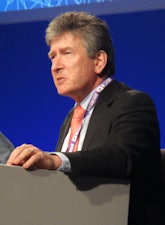
Productivity is a word that gets thrown around a lot these days. It's a familiar concept in industry and in macroeconomics, of course, but it is now cropping up more and more in healthcare. What might it mean in radiology?
A very important initial distinction must be made between the productivity of a radiology service or department and the productivity of an individual radiologist.
The productivity of a radiology service can be assessed in general terms by measures such as the number of examinations performed per whole time equivalent member of staff or the cost per examination. When these data have been collected in the U.K., they tend to demonstrate considerable variation in every parameter that has been assessed. Even when allowance is made for the inevitable vagaries of data collection -- different respondents choosing to interpret different questions in particular ways -- much of it seems to represent genuine variation. The evaluation of department productivity in this way and benchmarking against other similar services can help to provide service managers with the levers they require to secure additional funding in the face of other competing priorities.
 Dr. Giles Maskell.
Dr. Giles Maskell.The assessment of the productivity of an individual radiologist is much more complex and fraught with difficulty. It is also crucially dependent on the context in which the individual is working. For example, radiologists vary considerably in the rate at which they recommend further imaging studies in their reports (Potchen 2006). A radiologist who recommends a large number of follow-up investigations might be considered highly productive in an environment in which practice income depends on generating additional work, but definitely not in a cost-constrained publicly funded healthcare system such as the U.K.'s National Health Service (NHS).
And what about the question of "accuracy"? Who is more productive, the radiologist who accurately reports 20 studies in a morning or the radiologist who reports 40 but gets 10 of them wrong? Of course, the relationship between speed and accuracy is not linear, but the avoidance of just one major error leading to litigation by the use of a more time-consuming process of interpretation, perhaps using a second reporter (Maskell 2017), could easily pay for itself. We know that radiologists vary greatly in the time they will take to report a batch of plain radiographs when under no pressure (Edwards et al 2003), but we also know that increased speed of reporting of complex studies can lead to an increased rate of error (Sokolovskaya et al 2015).
Any temptation to assess the productivity of an individual based solely on the number of examinations reported or the number of procedures performed should be strongly resisted. There's a great deal more to it than that. One frequently neglected aspect is the impact that we have on each other. There are individuals who bring such enthusiasm to their work that their presence in the department enhances the performance of the whole team. Others may have a different effect.
All of us tend to overvalue our own contributions to any collective enterprise. You may well be familiar with the research that shows when each member of a couple is asked to estimate their own contribution to household chores, the sum of the two estimates always comes to well over 100% (Kahnemann 2011)! The same applies in radiology departments. If every member of the team comes to work determined to do their own share and no more, there will be a significant shortfall in the work delivered and an unhappy department.
In his wonderful book Predictably Irrational (HarperCollins, 2009), behavioral economist Dan Ariely explores the complex interplay between social and market norms in our lives. In a very simple experiment, he and his colleagues demonstrated while participants in a study were found -- as expected -- to work harder when offered more money, a group who were invited to perform the same task for nothing "as a favor" worked harder still. In other words, factors other than money can motivate us to work harder, and, in fact, money may be the most expensive way of getting more work out of people.
It's not that difficult to imagine the social factors that might enhance productivity in radiology departments -- a sense of belonging to a well-functioning team, a well-appointed and welcoming working environment, and the satisfaction of providing a high-quality service to a local population are all examples.
One conclusion of Ariely's research is that when social and market norms collide, market norms win every time. Once a task has moved from being something we do because we feel good about it to something we do for cash, it is very hard to reverse that. It also means that relying on a mix of goodwill for some elements of a service and hard cash for others is a recipe for trouble. Many U.K. radiology services are currently in this position.
We can expect to hear more about productivity in the years ahead. It's worth remembering there is a human dimension to it as well as a mathematical one.
Dr. Giles Maskell is a radiologist in Truro, U.K. He is past president of the U.K. Royal College of Radiologists. Competing interests: None declared.
References
- Ariely D. Predictably Irrational. New York City, NY: HarperCollins; 2009.
- Edwards AJ, Ricketts C, Dubbins PA, Roobottom CA, Wells IP. The effect of reporting speed on plain film reporting errors. Clin Radiol. 2003;58(12):971-979.
- Kahneman D. Thinking, Fast and Slow. New York City, NY: Farrar, Straus, and Giroux; 2011.
- Maskell, G. The practice of radiology needs to change. BMJ, 2017;358:j4102.
- Potchen EJ. Measuring observer performance in chest radiology: Some experiences. J Am Coll Radiol. 2006;3(6):423-432.
- Sokolovskaya E, Shinde T, Ruchman RB. The effect of faster reporting speed for imaging studies on the number of misses and interpretation errors: A pilot study. J Am Coll Radiol. 2015;12(7):683-688.
The comments and observations expressed herein do not necessarily reflect the opinions of AuntMinnieEurope.com, nor should they be construed as an endorsement or admonishment of any particular vendor, analyst, industry consultant, or consulting group.



















